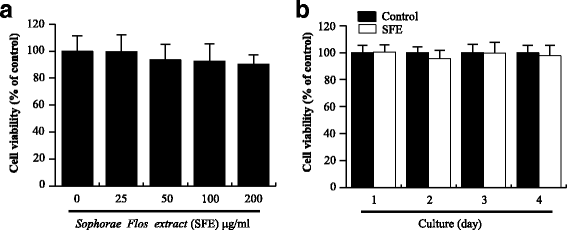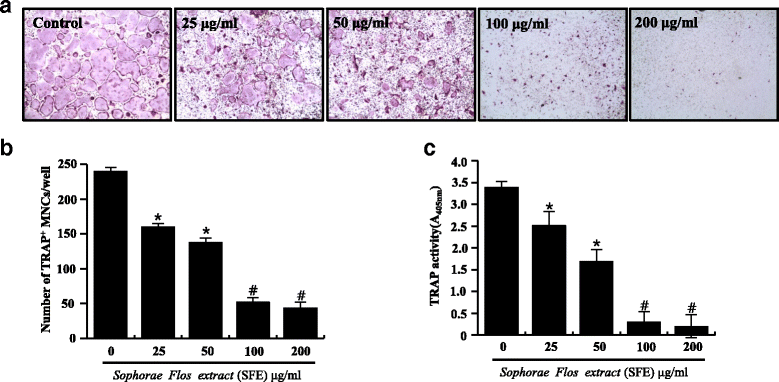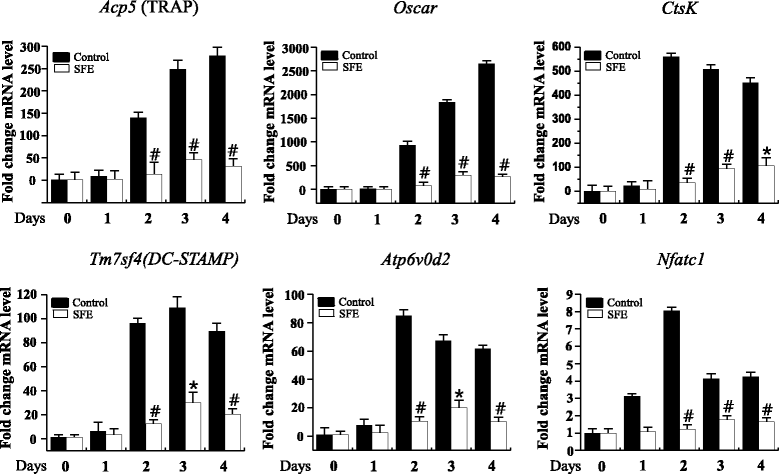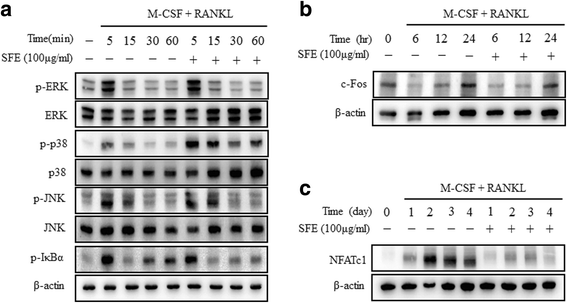Sophorae Flos extract inhibits RANKL-induced osteoclast differentiation by suppressing the NF-κB/NFATc1 pathway in mouse bone marrow cells
- PMID: 28335757
- PMCID: PMC5364702
- DOI: 10.1186/s12906-016-1550-x
Sophorae Flos extract inhibits RANKL-induced osteoclast differentiation by suppressing the NF-κB/NFATc1 pathway in mouse bone marrow cells
Erratum in
-
Erratum to: Sophorae Flos extract inhibits RANKL-induced osteoclast differentiation by suppressing the NF-κB/NFATc1 pathway in mouse bone marrow cells.BMC Complement Altern Med. 2017 Apr 28;17(1):235. doi: 10.1186/s12906-017-1745-9. BMC Complement Altern Med. 2017. PMID: 28454536 Free PMC article. No abstract available.
Abstract
Background: Sophorae Flos (SF) is a composite of flowers and buds of Styphnolobium japonicum (L.) Schott and has been used in traditional Korean and Chinese medicine for the treatment of hemostasis and inflammation. Previous studies reported that SF possesses anti-obesity properties, as well as anti-allergic, anti-proliferative, and anti-inflammatory activities. However, the effect of SF in bone resorption has not been studies. In this study, we examined the potential of SF extract (SFE) to inhibit receptor activator of NF-κB ligand (RANKL) -induced osteoclast differentiation in cultured mouse-derived bone marrow macrophages (BMMs).
Methods: BMMs, that act as osteoclast precursors, were cultured with M-CSF (50 ng/ml) and RANKL (100 ng/ml) for 4 days to generate osteoclasts. Osteoclast differentiation was measured by tartrate-resistant acidic phosphatase (TRAP) staining and the TRAP solution assay. Osteoclast differentiation marker genes were analyzed by the quantitative real-time polymerase chain reaction analysis. RANKLs signaling pathways were confirmed through western blotting.
Results: SFE significantly decreased osteoclast differentiation in a dose-dependent manner. SFE inhibited RANKL-induced osteoclastogenesis by suppressing NF-κB activation. By contrast, SFE did not affect phospholipase C gamma 2 or subsequent cAMP response element binding activation. SFE inhibited the RANKL-induced expression of nuclear factor of activated T cells c1 (NFATc1).
Conclusions: SFE attenuated the RANKL-mediated induction of NF-κB through inhibition of IκBα phosphorylation, which contributed to inhibiting of RANKL-induced osteoclast differentiation through downregulation of NFATc1.
Keywords: NF-κB; NFATc1; Osteoclast; PLCγ2; Sophorae Flos (SF).
Figures





Similar articles
-
Neogambogic Acid Suppresses Receptor Activator of Nuclear Factor κB Ligand (RANKL)-Induced Osteoclastogenesis by Inhibiting the JNK and NF-κB Pathways in Mouse Bone Marrow-Derived Monocyte/Macrophages.Med Sci Monit. 2018 Apr 26;24:2569-2577. doi: 10.12659/MSM.909651. Med Sci Monit. 2018. PMID: 29698379 Free PMC article.
-
Stauntonia hexaphylla (Lardizabalaceae) leaf methanol extract inhibits osteoclastogenesis and bone resorption activity via proteasome-mediated degradation of c-Fos protein and suppression of NFATc1 expression.BMC Complement Altern Med. 2015 Aug 14;15:280. doi: 10.1186/s12906-015-0801-6. BMC Complement Altern Med. 2015. PMID: 26271279 Free PMC article.
-
Inhibition of receptor activator of nuclear factor-κB ligand- or lipopolysaccharide-induced osteoclast formation by conophylline through downregulation of CREB.Immunol Lett. 2014 Sep;161(1):31-7. doi: 10.1016/j.imlet.2014.04.006. Epub 2014 May 2. Immunol Lett. 2014. PMID: 24792671
-
Current Understanding of RANK Signaling in Osteoclast Differentiation and Maturation.Mol Cells. 2017 Oct;40(10):706-713. doi: 10.14348/molcells.2017.0225. Epub 2017 Oct 17. Mol Cells. 2017. PMID: 29047262 Free PMC article. Review.
-
RANKL as the master regulator of osteoclast differentiation.J Bone Miner Metab. 2021 Jan;39(1):13-18. doi: 10.1007/s00774-020-01191-1. Epub 2021 Jan 1. J Bone Miner Metab. 2021. PMID: 33385253 Review.
Cited by
-
Nanophase: An Effective Dispersion System for the Decoction of Kushen Huaihua for the Treatment of Ulcerative Colitis.Curr Drug Deliv. 2025;22(6):821-836. doi: 10.2174/0115672018351982250224062652. Curr Drug Deliv. 2025. PMID: 40012383
-
Potential of natural medicines for treatment of osteoporosis: a narrative review.J Tradit Chin Med. 2023 Feb;43(1):198-204. doi: 10.19852/j.cnki.jtcm.20221108.003. J Tradit Chin Med. 2023. PMID: 36640013 Free PMC article. Review.
-
Beneficial effect of pristimerin against the development of osteoporosis in ovariectomy-induced osteoporosis rats by the RANKL/TRAF6/NF-κB pathway.Arch Med Sci. 2019 Jul 22;18(6):1650-1658. doi: 10.5114/aoms.2019.86816. eCollection 2022. Arch Med Sci. 2019. PMID: 36457960 Free PMC article.
-
Immunoexpression of canonical Wnt and NF-κB signaling pathways in the temporomandibular joint of arthritic rats.Inflamm Res. 2019 Oct;68(10):889-900. doi: 10.1007/s00011-019-01274-4. Epub 2019 Aug 1. Inflamm Res. 2019. PMID: 31372663
-
Sarsasapogenin Suppresses RANKL-Induced Osteoclastogenesis in vitro and Prevents Lipopolysaccharide-Induced Bone Loss in vivo.Drug Des Devel Ther. 2020 Aug 24;14:3435-3447. doi: 10.2147/DDDT.S256867. eCollection 2020. Drug Des Devel Ther. 2020. PMID: 32943842 Free PMC article.
References
-
- Kong YY, Yoshida H, Sarosi I, Tan HL, Timms E, Capparelli C, Morony S, Oliveira-dos-Santos AJ, Van G, Itie A, Khoo W, Wakeham A, Dunstan CR, Lacey DL, Mak TW, Boyle WJ, Penninger JM. OPGL is a key regulator of osteoclastogenesis, lymphocyte development and lymph-node organogenesis. Nature. 1999;397:315–23. doi: 10.1038/16852. - DOI - PubMed
MeSH terms
Substances
LinkOut - more resources
Full Text Sources
Other Literature Sources
Research Materials
Miscellaneous

